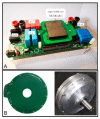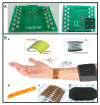Printed Circuit Boards: The Layers' Functions for Electronic and Biomedical Engineering
- PMID: 35334752
- PMCID: PMC8952574
- DOI: 10.3390/mi13030460
Printed Circuit Boards: The Layers' Functions for Electronic and Biomedical Engineering
Abstract
This paper describes the fabrication opportunities that Printed Circuit Boards (PCBs) offer for electronic and biomedical engineering. Historically, PCB substrates have been used to support the components of the electronic devices, linking them using copper lines, and providing input and output pads to connect the rest of the system. In addition, this kind of substrate is an emerging material for biomedical engineering thanks to its many interesting characteristics, such as its commercial availability at a low cost with very good tolerance and versatility, due to its multilayer characteristics; that is, the possibility of using several metals and substrate layers. The alternative uses of copper, gold, Flame Retardant 4 (FR4) and silver layers, together with the use of vias, solder masks and a rigid and flexible substrate, are noted. Among other uses, these characteristics have been using to develop many sensors, biosensors and actuators, and PCB-based lab-on chips; for example, deoxyribonucleic acid (DNA) amplification devices for Polymerase Chain Reaction (PCR). In addition, several applications of these devices are going to be noted in this paper, and two tables summarizing the layers' functions are included in the discussion: the first one for metallic layers, and the second one for the vias, solder mask, flexible and rigid substrate functions.
Keywords: Printed Circuit Board (PCB); biomedical; electronic; engineering.
Conflict of interest statement
The authors declare no conflict of interest.
Figures





















References
-
- Gilleo K., Murray J. The Definitive History of the Printed Circuit. PC Fab. 1999:1–16.
-
- Petherbridge K., Evans P., Harrison D. The origins and evolution of the PCB: A review. Circuit World. 2005;31:41–45. doi: 10.1108/03056120510553211. - DOI
-
- Baynes J. Method of Etching on One or Both Sides. 378,423A. U.S. Patent. 1888 February 28;
-
- Hanson A. Electric Cable. 782,391A. U.S. Patent. 1905 February 14;
-
- Berry A. Improvements in or Relating to Electric Heating Apparatus. 191,314,699A. G.B. Patent. 1913 June 25;
Publication types
Grants and funding
LinkOut - more resources
Full Text Sources
Miscellaneous

